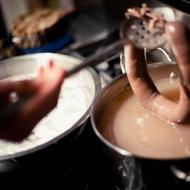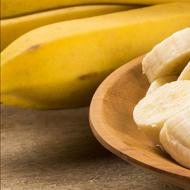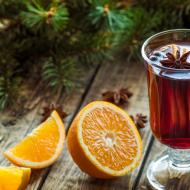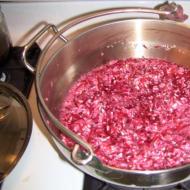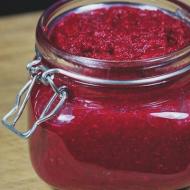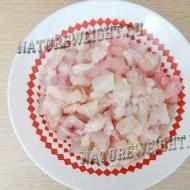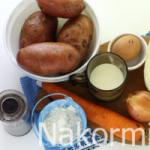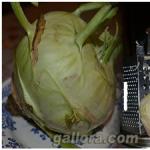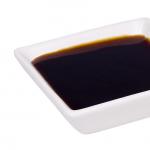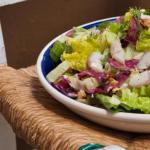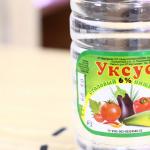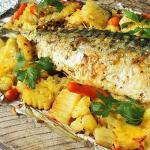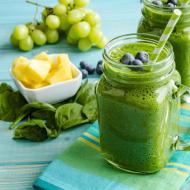
Spicy spices for biscuit dough. What spices are most often used for baking? Spices for preparing mushroom dishes
Professional bakers love to use different combinations of spices in their baked goods. The number of such mixtures is enormous. Let's take three compositions as an example:
- Anise, star anise, cinnamon, cumin, garlic, mint. This mixture of spices gives bread (especially rye) a sharp, spicy taste and a unique aroma.
- Cumin, coriander, anise, fennel. This composition is suitable for any bread dough. For 500g of flour, 1 tablespoon of the mixture is enough.
- This aromatic spice combination is called garam masala and is of Persian origin. Ingredients: coriander, cumin, black pepper, a little cinnamon, cardamom, nutmeg and cloves. Powdered spices are added when kneading the dough and give the bread an unusually subtle aroma.
Probably, many of you will be perplexed: how is it that these same spices are also suitable for meat, they are added to first courses, salads, etc. Now don’t be surprised: the baking spice mixture is quite suitable for fish. It is enough to replace the base: sugar with salt! This ability of a spice to be universal has long been noticed by professional chefs; spices are valued and studied for these qualities. It's all about combinations of herbs with each other and doses.

Star anise (star anise) for baking
Dry ripe fruits are used as a spice. The taste is bittersweet. The smell is reminiscent of anise, but much subtler and more aromatic, not cloying. Used for baking gingerbreads, cookies, pretzels. The aroma of the spice will develop as the product cooks, which will serve as a sign of readiness.
Vanilla for baking
The spice is considered the “aristocrat” among spices. It has an amazing lasting aroma. It is used in the manufacture of biscuits, pastries, and nut cakes. Great for baking containing cocoa.
Cloves in baked goods
The unopened flower bud of the myrtle tree, dried in the sun, has a strong aroma and pungent taste. For baking, it is better to use the spice cap, which has a subtle aroma without the bitterness of the stem. The value of clove is its essential oil of complex composition. Its content reaches 15%. When adding to dough, large doses should be avoided: 4 heads are enough for 1 kg. Cloves pair well with cinnamon. In spice mixtures for baking, the mixture should be kept in a ratio of 1:5 or 1:7.
Baking with ginger
The spice for sweet baking is used in the form of powder or finely ground root. A favorite spice in the preparation of gingerbread, biscuits, buns, cookies, and Easter cakes. It is added to the dough either during the kneading process or at the end. Adding rate: for 1 kg of dough - up to 1 g of ginger.
Cardamom in baking
This spice is included in almost all baking spice compositions. The main function of cardamom is to give the product an unusual aroma. The spice is indispensable in baking muffins, biscuits, puff pastry, and coffee cake. The filling rate should be careful: one crushed grain per 1 kg of dough is enough.
Baking with cinnamon
The spice is well known and loved by many. It has a delicate aroma, slightly burning, sweetish taste. Suitable for any type of baking, but especially good in combination with apples. Bookmark rate: half a teaspoon of chopped cinnamon per 1 kg of dough.
Nutmeg in baking
The spice has a refined aroma and a fiery spicy taste. Biscuits, cakes, cookies, sweet pies with the addition of nutmeg are considered spectacular and especially piquant.
Baking with lemon zest
Lemon zest has long been widely used in baking any sweet products. The wonderful aroma and the absence of citric acid make muffins, cakes, biscuits, pastries, buns and other baked goods aromatic and incredibly tasty.
Baking with saffron
The fragile threads of saffron have a strong aromatic odor, which is called intoxicating. The taste is spicy, slightly bitter. Added to cookies, buns and muffins to give a special accent and bright color to the product. The filling rate is scanty: 0.1 g per 1 kg of dough.

Researchers of spices and herbs, professional chefs and confectioners have discovered two interesting rules:
- when combining spices separately with some product, they will interact perfectly together;
- at the same time, the number of spices that make up the composition does not matter: there can be two or ten.
The purpose of spices is to add subtle shades of aroma and taste. A huge number of herbs and their mixtures can be found in encyclopedias and reference books.
We limited ourselves to a small list of our favorite spices. Having a wide range of spices on hand, knowing how and where to use aromatic seasonings for baking, and a creative approach are essential conditions for success. And then it’s a matter of technology. Don't be afraid to experiment!


In the article we talk about spices, talk about their beneficial properties and use in cooking. You will learn what types of spices there are, what seasonings and spices are good for health. Using our tips, you will learn how to choose the right flavorings for your dishes.
Spices or spices are food additives of plant origin. They have a stable taste and aroma. The role of spices does not end with improving the taste of a dish - they promote digestion and extend the shelf life of foods.
In Rus', spices were called spices, from the word “pepper” - the first known flavoring additive. Spices should not be confused with seasonings; the latter also mean salt, sugar, vinegar and other non-vegetable additives.
Various parts of plants are used as spices: leaves, stems, roots, flowers, fruits, seeds, bark and skin.
Useful properties of spices
Review of popular spices and seasonings.
Spices promote the active secretion of gastric juice and improve the digestion process. Depending on the chemical composition, food additives have a whole range of beneficial properties.
Many herbs are used to normalize blood pressure and heart rate. Valerian, mint and lemon balm reduce blood pressure, eliminate tachycardia, calm the nervous system and relieve headaches. If you suffer from hypotension, use rosemary, turmeric, and hot red pepper in moderate dosages.
To boost your immunity, drink tea with ginger. Garlic, fennel and oregano have an immunomodulatory effect.
Saffron, cinnamon, cloves, cumin and black pepper will help eliminate pain in the head and body. We talked in more detail about the beneficial effects of each spice in separate articles.
Types of spices
There are a huge number of spices - hot spices, sweet spices, spicy vegetables and herbs. Understanding this diversity is often difficult.
In the table we have given you the taste characteristics of the most popular spices and the dishes to which they are added.
Spice table:
| Name | Taste | Where do they add |
| Cinnamon | Sweetish, warm, burning, tart-astringent. | Cinnamon is used to prepare aromatic pastries, desserts, chocolate, hot soft and alcoholic drinks, for example, mulled wine. Cinnamon and apples go perfectly together. |
| Carnation | Burning taste and peculiar strong odor, contains essential oil. | Used in the manufacture of marinades, added to meat and fish dishes, confectionery, compotes and preserves. |
| Cardamom | Strong sweetish spicy taste and aroma. Contains essential oil. | Add to baked goods, confectionery and drinks. Coffee and tea are brewed with cardamom, and hot alcoholic cocktails are prepared. |
| Ginger | Pungent burning taste and aromatic characteristic odor. | Most often, ginger is added to baked goods, alcoholic and non-alcoholic drinks, and sauces for main dishes. |
| Turmeric | Mildly spicy, pleasant, in large quantities - sharp, burning. | Add to soups, vegetable stews, meat and fish dishes, sauces, and confectionery. |
| Nutmeg | Hot spicy taste and unique aroma. | Nutmeg is a universal seasoning. It is added to meat and fish dishes, rice and vegetable dishes, salty and sweet sauces. Most often used for baking, making confectionery, compotes, preserves and jams. |
| Black pepper | Burning, sharp. | Used for preparing soups, meat, fish and vegetable dishes, salads, sauces. Add to marinades, canned food, pickles. |
| Allspice | Spicy and fiery taste that resembles a mixture of cinnamon, nutmeg and cloves. | Add to meat first and second courses, marinades, canned food, sauces. Pairs best with grilled meat and game. Often used for pickling cucumbers. |
| Cayenne pepper | Very sharp, burning. | Add to meat dishes, legume dishes, sauces. To add a fiery taste, cayenne pepper is added to chocolate and chocolate baked goods. |
| Rosemary | Strong sweetish and camphorous aroma, reminiscent of pine. The taste is spicy, islandy. | Most often added to fish and vegetable dishes, fried meat and poultry. Rosemary is used to make syrups that are added to baked goods and drinks. |
| Saffron | Bitter spicy taste and strong unique aroma. | Add to rice and pea dishes. Used in small quantities in the preparation of red meat, fish soups and vegetable broths. |
| Zira | Bitter nutty taste and smell. | In most cases, it is used for pilaf and other rice dishes, added to meat dishes and marinades. |
| Thyme | Pungent spicy taste and strong pleasant aroma. | Thyme can be added to almost all dishes; it goes well with meat, fish, and vegetables. Twigs of the plant are added as a flavoring to sweet and savory baked goods and drinks. |
| Basil | Spicy island taste and pleasant aroma. | Basil is added to pasta, pizza, meat dishes, soups, salads and sauces. |
| Oregano | Pleasant spicy taste and aroma. | Used for chicken and fish, added to pizza and pies fillings, sauces and marinades. |
For more information about some spices, watch the following video:
Spices for health
At the beginning of the article, we already said that spices are good for health. Below is a list of the healthiest spices.
Remember that treatment with spices can only be carried out as an auxiliary measure to the main therapy. Before using spices for medicinal purposes, read the contraindications and consult your doctor. The benefits and harms of spices depend on the dosage and application.
Spices for weight loss
Many spices improve metabolism and digestion, and some even promote the breakdown of fats. Below we have presented the most effective spices for weight loss.
What spices can be used to reduce excess weight and why:
| Name | How it works | How to use |
| Ginger | Improves digestion and activates metabolism. Due to its pungent taste, ginger accelerates blood circulation, which promotes active fat burning. | Grind 100 g of fresh ginger and pour 500 ml of boiled hot water. Leave for 1 hour. Use 2-3 times a day, 1 glass of the product, drink the drink after meals. |
| Cinnamon | Speeds up metabolism and improves digestion, reduces blood sugar and controls appetite, and also dulls the feeling of hunger. | Add ½ tsp. ground cinnamon into a glass of kefir. Replace your last meal with the drink or drink it 1 hour after eating, preferably before bed. |
| Caraway | Improves digestion, normalizes lipid metabolism. | Pour 1 tbsp. seeds with a glass of boiling water, leave for 1 hour. Strain the drink and drink it at one time before your last meal. |
| Mint | Relieves the tension that is common for people on a diet, eliminates bloating, and reduces appetite. | Pour 6 mint leaves with 1 liter of boiled water. Leave for 20-30 minutes. Take the decoction warm 3-4 times a day, 1 glass. |
| Black pepper | Stimulates the production of gastric juice and improves the digestion process, accelerates metabolic processes and promotes fat burning. | In 500 ml of hot boiled water, stir a tablespoon of honey and the same amount of grated ginger. Add 1 tablespoon lemon juice and ground black pepper on the tip of a knife. Take the drink warm, 1 glass 2 times a day. |
| Rosemary | Improves blood circulation and stimulates metabolism. | Pour 1 tablespoon of rosemary into 500 ml of water, leave for 30 minutes. Take half a glass of the decoction, you can sweeten it with honey. |
| Anise | Reduces appetite, increases performance and improves mood. | Pour 5 g of anise with a glass of boiling water. Infuse the drink for 30 minutes, strain. Take the decoction 1/3 cup 3 times a day 30 minutes before meals. |
Spices aphrodisiacs
Some spices are strong aphrodisiacs. They increase libido, enhance sexuality and sensuality.
Spices are aphrodisiacs for women:
- Anise - ignites passion between partners.
- Vanilla - awakens femininity and increases sensuality.
- Cinnamon - enhances desire, provides a rush of blood to the intimate organs and increases the tone of the uterus.
- Cardamom - increases libido.
- Chili pepper - enhances the sensuality of erogenous zones.
- Nutmeg - increases libido and enhances sexuality.
Spices are aphrodisiacs for men:
- Ginger - increases male strength, ensures long-lasting sexual intercourse, improves blood circulation in the genitals.
- Coriander - increases attraction to the opposite sex.
- Marjoram - relaxes the body and increases libido.
- Saffron - increases sensitivity.
- Pepper - improves blood circulation and increases sensitivity.
- Savory - increases male strength and prolongs sexual intercourse.
What spices can children eat?
It is recommended to add spices to the diet of children from 2-4 years of age, depending on the spice itself. For example, dill can be introduced into the menu for a 10-month-old child, but it is better to refrain from using black pepper until the age of 5.
What spices are allowed for children over 2 years of age:
- dill;
- fennel (from 4 months);
- parsley (from 10 months);
- basil;
- ginger;
- cinnamon;
- garlic.
Which spices are contraindicated for children under 5 years of age:
- red hot pepper;
- saffron;
- turmeric;
- mustard;
- horseradish;
- coriander.
Consult your pediatrician about introducing these spices into the menu of a child over 5 years old.
Spices storage
Spices should be stored in glass or wooden jars in a dry and dark place. Whole spices have a longer shelf life than ground spices. Below are the expiration dates for different types.
Whole Spices and Herbs:
- leaves and flowers - 1-2 years;
- seeds 2-3 years;
- root vegetables - 3 years.
Ground spices:
- leaves and flowers - 1 year;
- seeds - 1 year;
- root vegetables - 2 years.
What to remember
- Spices or spices are plant-derived flavorings.
- Spices have a pronounced taste and aroma; they are added to food in small quantities.
- Spices have beneficial properties and are used to treat and prevent diseases. Before using spices for medicinal purposes, consult your doctor.
Spices are typically obtained from the seeds, roots and barks of plants that have a pleasant aroma. Spices are added to various dishes, including baked goods. Thus, confectionery acquire their own individual taste and aroma.
Confectionery with the addition of spices they are prepared in all bakeries. And it’s simply impossible to imagine baked goods without a piquant hint of spices. What spices are most often added to confectionery?
We will tell you about the most popular spices used in cooking.
We'll start with perhaps the most popular baking spice - vanillin. Vanillin is a spice with a pleasant, sweet smell that is extracted from the vanilla fruit. Almost everything confectionery this spice is added. Moreover, most often we use a chemical substitute for spices, which has a richer aroma. Natural sugar is vanilla sugar or vanilla pods, which are also used in cooking.

Another spice you can’t imagine without. confectionery- this is cinnamon. Extremely aromatic and spicy, cinnamon is ideal for baking, giving it a special appeal. Ground cinnamon is sprinkled on the baked goods, added to the dough itself, or the filling is formed with its addition. There are many ways to decorate confectionery with this wonderful spice.
Cardamom will add an exotic taste to baked goods. Cardamom pod can be added to drinks or to cakes, mousses or ice cream. makes an incomparable aroma and tart taste confectionery more appetizing and original. Cardamom seeds are most often found in pods from which they are removed before crushing. Their aromatic taste makes a delightful addition to sweet dishes.
Muscat is also used to diversify confectionery. The combination of nutmeg in dairy dishes or puddings is especially pleasant. Nutmeg is usually added to baked goods along with other spices to create a real spicy bouquet.

Cloves are perhaps the most aromatic spice, which is actively used not only for desserts, but also for preparing main dishes. Cloves go well with both meat and sweet baked goods. It complements the flavor of fruit and is most delicious when used with other spices.
In this list of spices that most often decorate confectionery, we can’t help but mention ginger. It has a spicy and quite aromatic specific taste. It is often added to cakes and cookies to add flavor to the dish.
The use of spices for baking is a matter of taste for every housewife. Not all of them are to the taste of lovers of aromatic baked goods. But the good thing about spices is that they can be used after baking. If you are a big fan of cinnamon or, for example, cloves, you can always add them to the finished product, sprinkling it at your discretion.
Common words.
Spices with a sweet-hot taste are best suited for baking and desserts. Or those whose bitterness is lost against the background of a strong aroma.
Odor carriers can be either spices themselves or their natural extracts. Liquid - in the form of flavored waters, alcohols, syrups, or solid - in the form of flavored sugar or powder. This is even more convenient for soaking a product or preparing cream or sauce.
Spices or mixtures thereof are added at different stages of preparation and in different media, depending on the recipe. For example, for muffins, it is more convenient to mix ground spices with flour, starch or cocoa. In yeast pies, spices are added to the filling. For lavender meringues, spices are mixed with powdered sugar. Flavored creams and glazes are used for choux and puff pastry.
Pictures are clickable.
CINNAMON
It’s logical to start our review of baking spices with cinnamon, as the most common and sought-after spice. The photo shows two types that are best suited for sweet dishes. The best dessert cinnamon is Ceylon. Unfortunately, I haven’t met her here in Russia. In the photo these are pieces of bark as thick as a sheet of paper, tightly rolled in several layers into tubes. It has a pronounced sweet taste and complex aroma, which, unfortunately, quickly dissipates when heated, leaving only a basic cinnamon smell. Therefore, it is better to leave Ceylon cinnamon to decorate desserts, baked goods and cold drinks or cappuccino foam before serving.
Indian cinnamon was replaced by its variety from Indonesia. In the photo these are pieces of bark, about 2-3mm thick, twisted into a curl. It contains almost no sweetness, and its smell is simpler than that of Ceylon cinnamon. Its advantage is its versatility: it is used in all types of baked goods and for decoration before serving. And also in any type of drinks - both hot (tea, mulled wine, etc.) and cold (milkshake, cranberry juice, etc.)
VANILLA
Vanilla has no less number of fans when it comes to sweet dishes. The spice market offers a wide variety of both vanilla itself and products made from it. How to sort them all out?
A reputable manufacturer puts the product on display by placing it in transparent, hermetically sealed tubes, and the quality of the vanilla can be easily discerned. For example, like in the left photo. The highest quality vanilla pod is over 20cm long, about 1.5cm thick, shiny in appearance, soft to the touch, so easy to roll or tie in a knot. Most often we sell dried or even brittle pods, packed in a laminated paper bag or in cellophane. This means that this vanilla is the cheapest one that is processed to obtain vanilla extract, or the pods have been lying somewhere for a long time.
Vanilla extract is an alcoholic extract from substandard vanilla pods. Homemade extract is prepared simply: you need to gut 3-4 vanilla pods per 0.5 liter of brandy or rum.
“Vanilla sugar” or “vanilla powder” is often found on sale. The correct name for this chemical product is “vanillin sugar”. You can also find regular sugar soaked in vanilla extract, or powder with specks of ground pod. In this case, they usually write “with natural vanilla” or “with natural vanilla extract.”
You need to store vanilla as it is - in a closed test tube, and use the entire pod at once. If there is a lot of whole pod, the rest can be put in powdered sugar.
Add the contents of the pod or natural vanilla extract to the liquid part required by the recipe - egg-butter mixture, cream, milk, melted chocolate, etc.
As a rule, vanilla acts alone, not combined with any other spices. Traditionally - with chocolate, dairy desserts, caramel. Vanilla with coconut baked goods is very good.
GINGER
The next most popular for baking is ginger. Today, all three of its faces are increasingly in demand in gingerbread baking. This is fresh ginger, candied ginger and ginger syrup or jam and dried ginger. Any type of it is added in small quantities, otherwise it can greatly spoil the dessert or baked goods.
The most complex, fresh smell and strong burning taste of fresh ginger root.
The one we sell is often, and almost always, quite fibrous and tough, and the central root also has a strong bitterness. Therefore, to use it in desserts and baked goods, it is more convenient to use ginger juice “with pulp” or puree. For small quantities, you can use a garlic press or the finest grater.
Fresh roots are stored well for about a month in the refrigerator, in the vegetable compartment, gradually losing moisture. For longer storage, it is easy to make ginger syrup or ginger jam from them. Both go well with citrus juice and zest in lime-ginger confiture, for example.
Dried ginger roots, as well as candied fruits and syrup, remove freshness and reduce bitterness.
Dried ground ginger goes well with all the classic spice blends. It is better to buy a small amount of ground ginger; it is better not to store it for a long time; over time, it acquires an unpleasant “earthy” tint and can give an unpleasant aftertaste in dessert dishes and baked goods.
Processed ginger has a warm, spicy aroma and a warming, pungent flavor. The syrup is used to decorate and impregnate finished products. Candied fruits - for baking.
CARDAMOM
The photo shows several types of cardamoms, the most accessible and fragrant of which is the ordinary green pod. The main flavor of cardamom comes from the seeds hidden in the pod. Cardamom, peeled from the pods, loses its smell quite quickly, which is why it is sold whole. Freshly ground cardamom has a very pleasant, sweet and at the same time fresh smell, accompanied by a hot-burning taste. The pungency of cardamom increases so much from type to type that one type of this spice is even called “grains of paradise pepper.” On the other hand, bleached cardamom is not at all hot, but its aroma is much weaker. Round Javanese or Chinese cardamom is distinctly reminiscent of anise.
Green cardamom is best suited for baking, drinks and desserts. On the other hand, if they add chili to chocolate, why not risk doing it with black cardamom, you just need to remove the “smoked” shell with a rough camphor smell.
A wonderful combination with cardamom is all nut and poppy seed baked goods and fillings. It is better to grind peeled cardamom seeds directly with poppy seeds or nuts. As a rule, 1 tsp is enough for 500g of poppy seed filling. regular cardamom.
NUTMEG
Nutmeg spices are also available in different forms, and, perhaps, nutmeg is the most convenient and best stored. The smell of freshly grated nuts, perhaps like no other, I would describe with the word “spicy and piquant”, despite this the spice has a rather bitter taste. Nutmeg, mace, and nut shells are much “lighter” in flavor, but, unfortunately, they are sold either already ground or broken. It’s easy for traders to understand – dry shells are fragile and brittle, and their packaging and transportation will make the spice more expensive compared to nuts.
I haven’t seen it on sale here, but most likely somewhere in the “spicy countries” you can run into wild nutmeg and its shells, which leads to disappointment: they smell so little and instantly lose their smell. The photo shows large pieces of shells. It's easy to distinguish. If a real nut is close in shape to an egg, then a wild nut is similar to an acorn.
Nutmeg is traditionally good in all combinations with other spices, separately - with chocolate, cocoa and whipped cream with cognac or whiskey. Nutmeg color, especially coarsely broken, is more convenient to add to drinks. Cocoa will also withstand freshly ground nuts.
CARNATION
Cloves are also carnations in Africa, the one and only. Regarding selection and purchase. Of course, you can’t see it through a closed bag, but the more whole, unbroken buds in the package, the fewer small and wrinkled branches, the higher the quality of the spice. Well, I never tire of reminding you about the expiration date indicated on the bag, so that it is as fresh as possible.
Cloves, in my opinion, are such a strong spice that it is not afraid of anything at all - no neighbors, no heat can clog its smell. I prefer to buy whole. But I don’t see any particular crime in ground cloves either, since the smell, although lost, is still capable of overpowering everything else in case of an overdose. Moreover, when baked goods are aged, the smell of cloves lasts longer than others and may even become predominant. That’s why I always “save” cloves.
But there is one classic combination where cloves pacify your temper. These are oranges + cloves. The acidity of the orange juice concentrates the scent of cloves, while at the same time the aroma of oranges enhances and softens the clove spice. And not only in glazes for pork and duck, but also in creams and desserts. The cloves should be heated in orange juice, allowed to cool and sit for a while, and then removed so that they do not darken the light cream, dough or glaze. If there is no such concern, as, for example, in chocolates, you can stir ground cloves in cold juice or mix with zest.
ALLSPICE
Allspice is also multi-tasking like cloves, but much softer in character. It also combines piquancy with an almost imperceptible bitterness. It is not worth buying ground allspice, since it contains much less essential oil than cloves, and grinding it is not difficult.
The benefits of allspice include the fact that it is more difficult to make mistakes in the dosage. The best combination for allspice is cane sugar, honey and caramel.
BLACK PEPPER
Despite the pronounced heat, pepper also has a bright spicy aroma and, in small quantities, can be useful in gingerbread mixtures. It is better to use black or green pepper as it is more flavorful. At the same time, the heat in baked goods is completely preserved, so if you add pepper, it is better not to combine it with ginger, since the heat will add up. For a large batch of cookies or gingerbread (40 pieces), just add 1/4 teaspoon of freshly ground pepper to the spice mixture.
Classic combinations
Apple with cinnamon creates a stunning combination of sweet and tart flavors. By adding a teaspoon of ground cinnamon to apples prepared for crumble (waffles), pie and strudel, you can enjoy an amazingly subtle taste. This combination goes well with brown grapes.
Dried fruits with seasonings complement each other, which helps to take advantage of this combination when preparing fruitcakes, plum pudding, raisin scones, cookies or pie filling.
Coffee and cardamom create an incomparable taste of exoticism. In order to fully experience the unique aroma, just dip a cardamom pod in hot milk and use this drink in coffee, or add it to cakes, mousses or ice cream.
Muscat adds finishing touches to smooth dairy dishes such as rice pudding.
Combinations cumin and orange creates a particularly aromatic taste. This shows up well in brownies or traditional caraway cake. You can also add it to cookies or scones.
Right choice
1. A spice mixture containing cinnamon, cloves, nutmeg and ginger, ideal for adding to puddings and cakes.
2. A spice such as cinnamon is available in ground form or in the form of sticks. Its piquant taste is perfectly felt in various dishes, especially those containing apples.
3. Anise is easily recognized by the sweet taste of licorice. You can buy it ground or in seed form. It goes well with other ingredients in cakes and sweets.
4. Cloves, with their pungent flavor, complement fruits well and are delicious mixed with other spices. It is used whole or in crushed form.
5. Vanilla is sweet and aromatic. It is added to other spices and is great when combined with chocolate. Vanilla is sold as an extract, essence or pod.
To store vanilla, do the following:
Fill a glass jar or jam jar with sugar and bury a vanilla bean in it.
Seal the jar tightly and store in a dark, cool place for several weeks.
The longer the pod remains in sugar, the more intense the aroma it emits.
You can use vanilla sugar instead of regular sugar in cakes, cookies and crumbles.

6. Cardamom seeds are usually sold in pods, from which they are removed before crushing. Their aromatic taste makes a delightful addition to sweet dishes.
7. Nutmeg is a bitter nut with an earthy flavor, which is especially noticeable in sweet pies and milk puddings, but for this it is better to use it freshly grated.
Adding a little grated nutmeg to rice while it's cooking can make a delicious porridge or casserole.
8. Ginger has a slightly spicy and quite aromatic taste. In crushed form, it is added to cakes and cookies.
9. Star anise is highly valued for its shape, as well as the bitter taste of anise. It is better to use it crushed or whole, combining it with fruit.
10. Clove berries, otherwise known as Jamaican peppers, taste like cloves, cinnamon, and nutmeg. Add to cookies, cakes and puddings.
11. Cumin is added to cakes and sweet breads. Its seeds have a subtle, pungent and rich taste.
12. Saffron is usually used in savory dishes, but can also be added to pies and bread. It is used extremely sparingly due to its overly characteristic odor.

